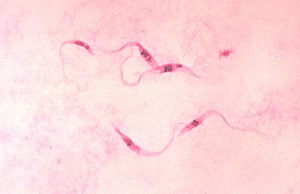Chaga's cardiomyopathy
| Chagas disease | |
|---|---|
| Synonyms | American trypanosomiasis |
 |
|
| Photomicrograph of Giemsa-stained Trypanosoma cruzi | |
| Pronunciation |
|
| Specialty | Infectious disease |
| Symptoms | Fever, large lymph nodes, headache |
| Complications | Heart failure, enlarged esophagus, enlarged colon |
| Causes | Trypanosoma cruzi spread by kissing bugs |
| Diagnostic method | Finding the parasite or antibodies in the blood |
| Prevention | Eliminating kissing bugs and avoiding their bites |
| Medication | Benznidazole, nifurtimox |
| Frequency | 6.6 million (2015) |
| Deaths | 8,000 (2015) |
| Classification |
· ·
|
|---|---|
| External resources |
Chagas disease, also known as American trypanosomiasis, is a tropical parasitic disease caused by the protist Trypanosoma cruzi. It is spread mostly by insects known as Triatominae or kissing bugs. The symptoms change over the course of the infection. In the early stage, symptoms are typically either not present or mild, and may include fever, swollen lymph nodes, headaches, or local swelling at the site of the bite. After 8–12 weeks, individuals enter the chronic phase of disease and in 60–70% it never produces further symptoms. The other 30 to 40% of people develop further symptoms 10 to 30 years after the initial infection, including enlargement of the ventricles of the heart in 20 to 30%, leading to heart failure. An enlarged esophagus or an enlarged colon may also occur in 10% of people.
T. cruzi is commonly spread to humans and other mammals by the blood-sucking "kissing bugs" of the subfamily Triatominae. These insects are known by a number of local names, including: vinchuca in Argentina, Bolivia, Chile and Paraguay, barbeiro (the barber) in Brazil, pito in Colombia, chinche in Central America, and chipo in Venezuela. The disease may also be spread through blood transfusion, organ transplantation, eating food contaminated with the parasites, and by vertical transmission (from a mother to her fetus). Diagnosis of early disease is by finding the parasite in the blood using a microscope. Chronic disease is diagnosed by finding antibodies for T. cruzi in the blood.
Prevention mostly involves eliminating kissing bugs and avoiding their bites. Other preventative efforts include screening blood used for transfusions. A vaccine has not been developed as of 2017. Early infections are treatable with the medication benznidazole or nifurtimox. Medication nearly always results in a cure if given early, but becomes less effective the longer a person has had Chagas disease. When used in chronic disease, medication may delay or prevent the development of end–stage symptoms. Benznidazole and nifurtimox cause temporary side effects in up to 40% of people including skin disorders, brain toxicity, and digestive system irritation.
...
Wikipedia
